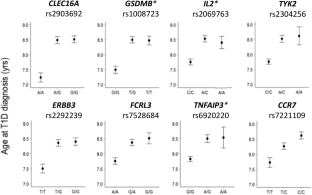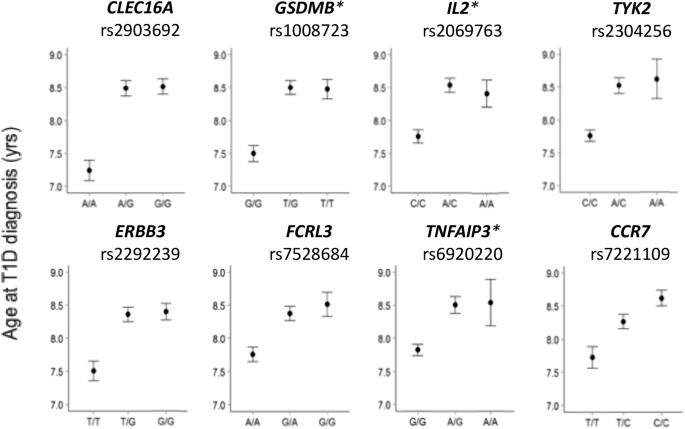与儿童发病型 1 型糖尿病确诊年龄相关的基因组变异。
IF 2.6
3区 生物学
Q2 GENETICS & HEREDITY
引用次数: 0
摘要
1 型糖尿病(T1D)的诊断年龄(AAD)是由自身免疫攻击的发病年龄和随后β细胞的破坏速度决定的。双胞胎研究发现,T1D 的 AAD 受遗传的影响很大,尤其是在幼儿中。之前在英国、芬兰和撒丁岛的年轻患者中发现了与 AAD 相关的基因组变异,这些变异可能会因人群和时间的不同而变化。在1980-2008年期间出生在法国本土的1956名15岁前宣布患有T1D的欧洲血统儿童中,我们使用非参数Kruskal-Wallis检验法检测了94个T1D相关SNP与AAD的关系。虽然未发现高风险 HLA 基因型与 AAD 相关,但位于 12 个非 HLA 位点的 14 个 SNPs 显示出很强的相关性(经 FDR 校正后为 2.9 × 10-12 -3)。这些位点中有四个在以前的队列中与 AAD 相关(GSDMB、IL2、TNFAIP3、IL1),支持所研究的欧洲人群对 T1D 的 AAD 有部分共同的遗传影响。相比之下,8个新基因位点CLEC16A、TYK2、ERBB3、CCR7、FCRL3、DNAH2、FGF3/4和HPSE2与AAD的关联则是新颖的。位于这些基因座内的 12 个蛋白编码基因参与了主要的免疫途径或其他自身免疫性疾病的易感性,这表明这些基因在β细胞破坏的早期免疫机制中起着重要作用。本文章由计算机程序翻译,如有差异,请以英文原文为准。


Genomic variants associated with age at diagnosis of childhood-onset type 1 diabetes
Age at diagnosis (AAD) of Type 1 diabetes (T1D) is determined by the age at onset of the autoimmune attack and by the rate of beta cell destruction that follows. Twin studies found that T1D AAD is strongly influenced by genetics, notably in young children. In young UK, Finnish, Sardinian patients AAD-associated genomic variants were previously identified, which may vary across populations and with time. In 1956 children of European ancestry born in mainland France in 1980-2008 who declared T1D before 15 years, we tested 94 T1D-associated SNPs for their association with AAD using nonparametric Kruskal–Wallis test. While high-risk HLA genotypes were not found to be associated with AAD, fourteen SNPs located in 12 non-HLA loci showed a strong association (2.9 × 10−12 < P < 1.4 × 10−3 after FDR correction). Four of these loci have been associated with AAD in previous cohorts (GSDMB, IL2, TNFAIP3, IL1), supporting a partially shared genetic influence on AAD of T1D in the studied European populations. In contrast, the association of 8 new loci CLEC16A, TYK2, ERBB3, CCR7, FCRL3, DNAH2, FGF3/4, and HPSE2 with AAD is novel. The 12 protein-coding genes located within these loci are involved in major immune pathways or in predisposition to other autoimmune diseases, which suggests a prominent role for these genes in the early immune mechanisms of beta cell destruction.
求助全文
通过发布文献求助,成功后即可免费获取论文全文。
去求助
来源期刊

Journal of Human Genetics
生物-遗传学
CiteScore
7.20
自引率
0.00%
发文量
101
审稿时长
4-8 weeks
期刊介绍:
The Journal of Human Genetics is an international journal publishing articles on human genetics, including medical genetics and human genome analysis. It covers all aspects of human genetics, including molecular genetics, clinical genetics, behavioral genetics, immunogenetics, pharmacogenomics, population genetics, functional genomics, epigenetics, genetic counseling and gene therapy.
Articles on the following areas are especially welcome: genetic factors of monogenic and complex disorders, genome-wide association studies, genetic epidemiology, cancer genetics, personal genomics, genotype-phenotype relationships and genome diversity.
 求助内容:
求助内容: 应助结果提醒方式:
应助结果提醒方式:


